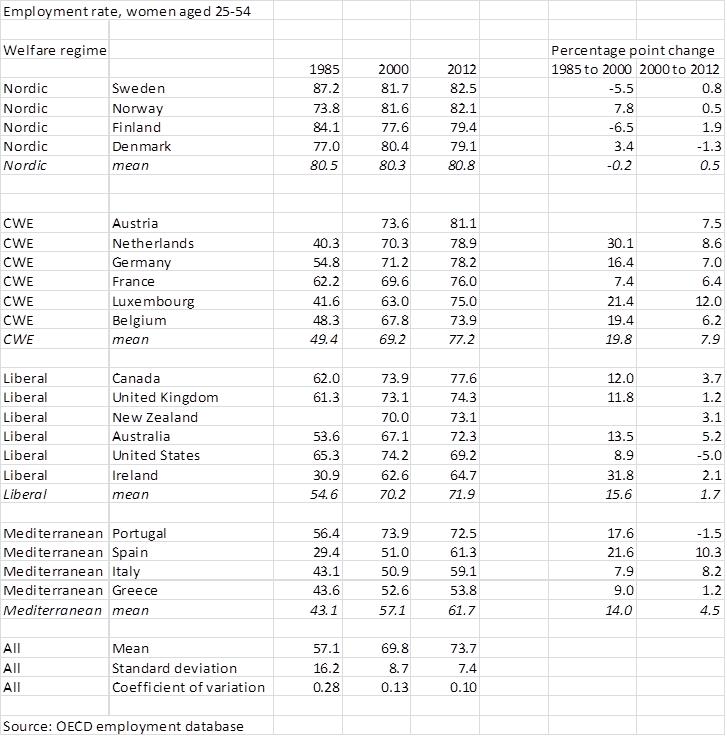The forward march of women's labour halted?

Alan Manning draws attention to the stagnation of women's economic progress here http://blogs.lse.ac.uk/politicsandpolicy/archives/35469 . Looking at the fortunes of successive birth cohorts of women*, there has been no reduction in the gender pay gap for women born around 1990 compared to those born ten years earlier. More strikingly, women born around 1980 faced a similar gender pay gap by their late thirties to women born around 1970. And while the former had higher employment rates during their mid-to-late twenties and early thirties compared to women born ten years earlier, this advantage was eliminated by age 35. All of which suggests that the impact of family responsibilities on women's earnings and employment really hasn't diminished as much as we might have expected.
It looks as if much of the forward march of women's labour which we have come to take for granted came to a halt some time ago, and younger women have little reason to expect to fare better in the labour market, at least by their mid 30's, than women born in the 1960s. Alan notes: 'This stagnation in the employment rates of the most recent cohorts of women is not unique to the UK – it has also occurred in the US. But, it is not entirely clear why it has happened. One possible reason is that the big sources of gender inequality have been dealt with – the end of the marriage bar, equal pay, maternity rights, rights to flexible working – and it has become harder to come up with new policies that one would expect to make a big difference.'
There is of course no reason to expect women's economic progress to continue at a constant rate: once employment rates have reached a certain point, we would expect progress to slow down. But when should we expect it to grind to a halt? One way of addressing this question this is to look at developments in other countries. In fact, international comparison doesn't indicate that the UK has reached a point where further progress on employment is ruled out. While in 2000 the UK could claim to have relatively high employment rates for women compared to many of its closest neighbours, this is no longer the case.
The table shows employment rates in the key 'prime age' band of 25-54 for 20 countries. To make comparison simpler, the table groups the data using a standard 'welfare regime' typology, based on institutional and historical commonalities between different welfare states. The groups are Nordic (sometimes referred to as 'social democratic'), Contintental Western European (CWE), Liberal (predominantly English-speaking) and Mediterranean.
We are used to the idea that Nordic welfare states have very high rates of female employment, and this is confirmed in the table with these countries averaging 81% compared to the UK's 74%. But a more interesting comparison may be between Liberal countries like the UK and the CWE countries, which historically tended not to prioritise women's work outside the home. In 2000, female prime age employment in the UK was comfortably ahead of all the countries in the CWE group apart from Austria. In 2012, the situation was the opposite, with all of the CWE nations apart from Belgium showing higher employment than the UK. Moreover three of the CWE countries - Germany, Austria and the Netherlands - show clear signs of converging with the Nordic countries (this is even more apparent when we look at younger women's employment, although you'll have to take my word for this as there isn't time or space to show this here). Across the CWE group as a whole, the prime age employment rate has increased by eight percentage points since 2000, reaching 77% compared to 72% for the Liberal group.
So while the UK has relatively high employment for women compared to some of the other countries in the Liberal group, it now lags behind most northern and western European countries. Why this should be the case deserves further investigation, and it would also be interesting to compare outcomes for women born in different years across countries as Alan has done for the UK. But if the forward march of women's labour has been halted in the UK, it doesn't look as if this is because it has hit some natural limit. This leaves us with the question of which of the 'big sources of gender inequality' remain to be addressed in the UK. At the same time, UK policy wonks concerned with women's employment might take some comfort from the fact that Nordic-style institutions no longer seem to be a necessary requirement for achieving employment rates of around 80%.
*pseudo-cohorts, to be pedantic
As older readers won't need to be told, the title of this article is pinched from http://www.amielandmelburn.org.uk/collections/mt/pdf/78_09_hobsbawm.pdf